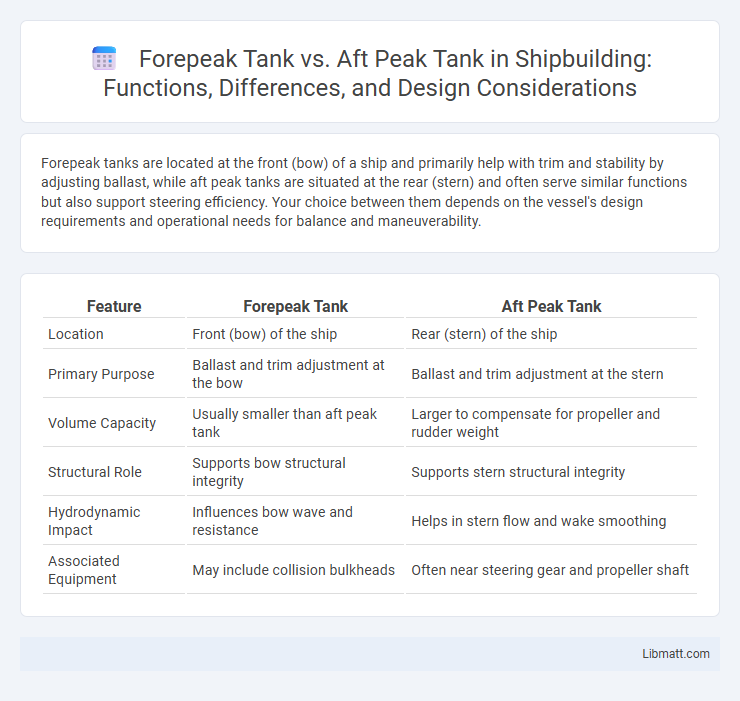Forepeak tanks are located at the front (bow) of a ship and primarily help with trim and stability by adjusting ballast, while aft peak tanks are situated at the rear (stern) and often serve similar functions but also support steering efficiency. Your choice between them depends on the vessel's design requirements and operational needs for balance and maneuverability.
Table of Comparison
| Feature | Forepeak Tank | Aft Peak Tank |
|---|---|---|
| Location | Front (bow) of the ship | Rear (stern) of the ship |
| Primary Purpose | Ballast and trim adjustment at the bow | Ballast and trim adjustment at the stern |
| Volume Capacity | Usually smaller than aft peak tank | Larger to compensate for propeller and rudder weight |
| Structural Role | Supports bow structural integrity | Supports stern structural integrity |
| Hydrodynamic Impact | Influences bow wave and resistance | Helps in stern flow and wake smoothing |
| Associated Equipment | May include collision bulkheads | Often near steering gear and propeller shaft |
Introduction to Peak Tanks
Peak tanks are crucial compartments located at the extreme ends of a vessel, serving primarily for ballast water management to maintain stability and trim. The forepeak tank is positioned at the bow, helping counteract pitching motions, while the aft peak tank at the stern balances the ship's longitudinal trim and supports safe maneuvering. Proper management of your forepeak and aft peak tanks ensures optimal vessel performance and structural integrity during voyages.
What is a Forepeak Tank?
A Forepeak tank is a dedicated compartment located at the forward-most section of a ship's hull, primarily used for ballast water to maintain the vessel's stability and trim. It counters the weight distribution by offsetting forces encountered during navigation, improving overall seaworthiness and fuel efficiency. Your understanding of these tanks ensures optimal ship balance and safety during voyages.
What is an Aft Peak Tank?
An aft peak tank is a compartment located at the stern of a ship, primarily used for ballast to improve stability and trim during voyages. Unlike the forepeak tank situated at the bow, the aft peak tank adjusts the vessel's trim by controlling the weight distribution at the rear, which is crucial for maintaining optimal hydrodynamic performance. Your understanding of the aft peak tank's role can enhance effective ballast management and contribute to safer, more efficient ship operations.
Key Functions of Forepeak and Aft Peak Tanks
Forepeak tanks primarily serve as ballast tanks located at the front of a vessel, providing stability and trim control during navigation, while aft peak tanks, positioned at the stern, balance weight distribution and aid in maneuvering. Both tanks are crucial for maintaining optimal draft and minimizing hull stress, especially during loading or rough sea conditions. Understanding the distinct roles of these tanks can enhance Your vessel's operational efficiency and safety.
Structural Differences: Forepeak vs Aft Peak Tank
Forepeak tanks are located at the forwardmost part of a ship and are structurally designed to withstand impact from waves and collisions, featuring reinforced bulkheads and curved hull sections to distribute stress evenly. Aft peak tanks, positioned at the rear, often have stronger framing to counteract the forces from propeller wash and steering gear vibrations. Both tanks incorporate corrosion-resistant materials, but forepeak tanks prioritize hydrodynamic pressure resistance, while aft peak tanks focus on structural stability under propulsion-induced loads.
Typical Locations and Design
Forepeak tanks are typically located at the forwardmost part of a vessel's hull, designed primarily for ballast and trim adjustment to enhance stability and seaworthiness. Aft peak tanks, situated at the stern, serve similar functions but are often tailored to accommodate propulsion system requirements and may have different structural reinforcements due to propulsion equipment proximity. Your vessel's design will dictate the exact dimensions and structural features of these tanks to optimize balance, safety, and operational efficiency.
Advantages of Forepeak Tanks
Forepeak tanks offer improved vessel stability by reducing pitching and enhancing trim control, which is critical in rough seas. They provide better compartmentalization for ballast water, minimizing the risk of contamination and allowing more precise weight distribution for optimal performance. Your ship benefits from enhanced structural integrity and safety due to the forepeak tank's position at the bow, absorbing impacts and reducing damage in collisions.
Benefits of Aft Peak Tanks
Aft peak tanks provide improved ship stability by counterbalancing weight distribution at the stern, enhancing maneuverability and fuel efficiency. They serve as effective ballast tanks that reduce trim by fine-tuning the vessel's draft and minimizing resistance during navigation. The location of aft peak tanks also allows for better protection of the propeller and rudder from damage during low-speed maneuvers or grounding incidents.
Operational Considerations and Safety
Forepeak tanks, located at the forward-most part of a ship, are critical for maintaining trim and stability during navigation, especially in rough seas, while aft peak tanks serve a similar role at the stern but are also vital for housing steering gear and propeller shaft seals, requiring careful monitoring to prevent contamination. Operational considerations include managing ballast levels to avoid structural stress and ensuring proper ventilation to mitigate the buildup of hazardous gases such as hydrogen sulfide or hydrocarbons. Safety protocols involve regular inspections, adherence to IMO ballast water management regulations, and use of gas detection systems to prevent accidents like tank over-pressurization or explosions.
Choosing Between Forepeak and Aft Peak Tanks
Choosing between forepeak and aft peak tanks depends on your vessel's balance and stability requirements, with forepeak tanks typically located at the bow and aft peak tanks positioned at the stern. Forepeak tanks are often used for ballast to improve trim and reduce bow slamming, while aft peak tanks contribute to stabilizing the ship's stern and enhancing propulsion efficiency. Understanding your ship's hydrodynamics and cargo distribution helps optimize the use of these tanks for maximum performance and safety.
Forepeak tank vs aft peak tank Infographic

 libmatt.com
libmatt.com